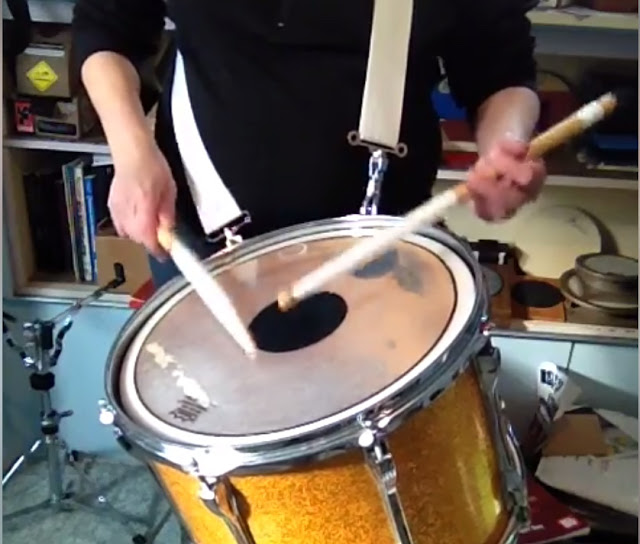Around the time I had graduated high school, some drum lines were experimenting with a head made of woven Kevlar (the same stuff found in bulletproof vests). Kevlar was the new miracle material; drums heads made from it could be tuned higher and tighter than any Mylar head. As a result, kids in the 1980s began putting Kevlar heads on their regular drums, cranking down the lug bolts, and playing hard enough to break lugs and drum shells.
Of course, this led to the development of high-tension drums, with a free-floating shell and a tubular lug that could withstand the forces of cranked-down Kevlar heads. Eventually it even led to drum tuning wrenches that could handle the torque required to tune a high-tension drum. (I have one of these and I only use it on the aforementioned drums. It's complete overkill for anything else.)
The result changed marching percussion forever. Modern drum corps and marching bands now use Kevlar or Kevlar-Carbon hybrid heads almost exclusively. Today's kids are learning to play on these heads from middle school onward, with the result that it's ruining their concert technique (because we still use Mylar heads in orchestral playing and they require a very different touch) and it's ruining their hands and wrists in the long run (because the tension is so high there's no real "give" and all the shock goes into the hands and wrists, causing fatigue and a high potential for tendon and joint injury in younger players).
I had just missed the Kevlar boat when my marching days ended; The one season I marched in college band the school was broke and still had older drums with Mylar heads. When I began coaching high school drum lines, nearly every one was equipped with high-tension drums and Kevlar heads. I had to adjust my playing approach, and my hands became fatigued early on. Eventually, I learned to play examples on a pad and let the snare players figure out on their drums. (I didn't yet know that high-tension drums could cause long-term issues; I just figured it was because I wasn't used to it.)
When I joined the UBB last year, I scored a used Dynasty Wedge snare and carrier to march with. The drum's sound was tight and crisp -- and completely out of p[lace for the second-line style of playing I was being asked to do. But it weighed far less than a regular high-tension drum, so I hung with it until I came across this Ludwig marching snare drum from the 1970s, around the time I played in high school band. After some fussing and cleaning and little help from the fellas at Revival Drum Shop, The drum has become a serious player. And I love it so much I've put my Wedge drum up for sale.
You'll notice that, with Mylar heads, you really have to draw the sound out of the drum more; you can't just let the sticks bounce happily away, because Mylar heads will require you to do a little of the work, controlling the strokes with your hands and wrists. (This i why, back when I marched, we practiced at night on our pillows before going to sleep in the gym on tour. The pillow made us do ALL the work, and we built up our chops as a result. Today, I'm sure wouldn't be able to pull of half of what I'm doing with my arthritic hands, if I had not worked out this way as a kid.)
You'll also notice a fuller, deeper sound with a lot more space in it. That's because of both the shape of the drum and the lower tension required for Mylar heads, both of which lend more depth and color to the snare drum's sound. (My drum is a 14" x 10" model -- try this in a 15" or 16" snare drum from the 50's and you'll be amazed at the depth and darkness of the tone.)
I've put the wedge and carrier up for sale on Facebook's Marching Percussion Marketplace, at what I think is a very good price for each.
Because you know what the other benefit of going back is? With a sling and leg rest, this drum weighs far less than my high-tension setup, and my whole body is happier.
Sometimes going retro is the right thing to do.
I'll never play Kevlar heads again. Because I don't need to.
Happy drumming!

No comments:
Post a Comment